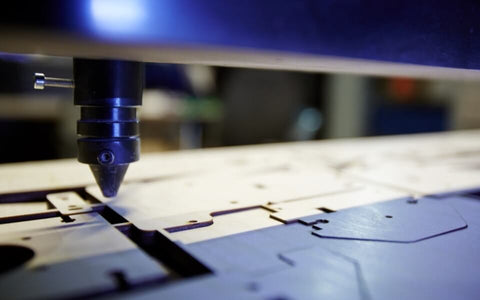Safety standards to be aware of for laser engraving in 2024
In a world where laser technology plays an increasingly central role in various fields, from creating delicate crafts to high-precision industrial manufacturing, the application of laser engraving machines is constantly expanding, bringing along new requirements for safety and environmental protection. As technology advances rapidly, we must ensure that operational safety and environmental responsibility are not overlooked in our pursuit of innovation and efficiency. This article aims to provide a comprehensive overview, explaining the classification of laser products' safety, recent updates on safety standards, as well as how to handle laser engraving machines safely and responsibly. Through this text, we will explore how to reap the benefits of laser engraving technology while ensuring the safety and well-being of people and the environment.
Overview of laser product safety levels
Laser products are classified into four main categories based on their potential hazard levels, ranging from Class 1 to Class 4.
Class 1 Lasers: These are the safest lasers, with an extremely low output power, typically below the minimum energy level that can cause harm to the eyes. Even after prolonged exposure, Class 1 lasers pose no risk to the human body. Therefore, they do not require specific protection or control measures. Under normal operating conditions, Class 1 lasers do not produce hazardous radiation.
Class 2 Lasers: These lasers have slightly higher output power but generally operate only in the visible light range (400-700nm). The natural reaction of the human body, such as blinking, is usually sufficient to prevent eye damage caused by Class 2 lasers. Thus, they are considered relatively safe for short-term exposure. However, prolonged direct exposure or viewing the beam with optical instruments can still be hazardous for Class 2 lasers.
Class 3 Lasers: They are divided into Class 3R and Class 3B. Class 3R lasers have higher output power than Class 2 lasers, but the risk remains limited. Class 3B lasers are more dangerous, and direct eye exposure to these laser beams can result in serious injuries.
Class 4 Lasers: These are the most dangerous lasers. Their output power is very high, and even diffuse laser light can cause eye and skin damage. Class 4 lasers can also ignite materials, requiring additional protection measures during their use, such as wearing specialized protective eyewear and appropriate clothing, as well as using professional containment and ventilation systems.
Among all these categories, Class 1 and Class 2 lasers are particularly important due to their relatively low risk. They are widely used in education, consumer electronics, and some commercial applications, such as laser printers, optical disc readers, and supermarket scanners. Since these devices are often handled by non-professionals, their safety is crucial. Manufacturers and users must ensure that these devices adhere to strict safety standards during their design and use to prevent any potential harm.

Key updates on laser engraving safety standards in 2024
Electromagnetic Compatibility and Mechanical Safety
With the proliferation of electronic devices in modern life, issues of electromagnetic interference (EMI) have become more concerning. Therefore, laser engraving machine manufacturers must ensure that their products can withstand EMI while not causing disruption to other devices. Additionally, updates in mechanical safety require equipment to be stable and reliable during operation, thereby reducing accidents caused by mechanical failures.

Integration of safety relays
A distinctive feature of advanced equipment such as OMTech laser engravers is the integration of safety relays compliant with the EN 13849-1 standard. These relays can quickly cut off the power supply in the event of detecting any abnormal operation or failure, thereby preventing potential damage or injuries.

Directive on Waste Electrical and Electronic Equipment (WEEE) and product recycling
The WEEE directive requires all manufacturers and users of electronic devices to take responsibility for their recycling and disposal at the end of their life cycle. Compliance with this regulation demands that users of laser engravers handle end-of-life equipment carefully to minimize their impact on the environment.

Safe operation of Class 1 and Class 2 lasers
Although Class 1 and Class 2 laser equipment are relatively safe, they still require adherence to certain operational procedures. For example, even though Class 1 lasers are fully enclosed, additional safety measures are necessary if the enclosure is removed during maintenance or servicing. For Class 2 equipment, operators should avoid direct viewing of the laser beam and use appropriate protective eyewear whenever possible.
Safety features and maintenance: Differences between Class 1 and Class 2 machines
Class 1 machines are typically designed with safety interlocks, interlocking devices, and other protective measures to ensure that the laser beam is not accidentally exposed. Class 2 machines may require additional user inputs, such as safety confirmations before starting, as well as continuous monitoring during use.

Operator training and safety awareness
Operator training involves not only the use of equipment but also its safe operation. This includes understanding equipment operation, potential risks, safe operating procedures, and emergency response measures. Training should encompass both theoretical learning and practical application, ensuring that operators remain safe in all situations.
Emergency management: Prevention and intervention
Even with all possible preventive measures, emergencies can still occur. Therefore, it is essential to develop and practice emergency plans. This includes knowing how to quickly and safely shut down the equipment, manage small fires, and contact emergency services if necessary.

Management of environmental safety and materials
The laser engraving process can generate dust and hazardous waste. Therefore, proper ventilation systems and waste management procedures are necessary. Additionally, compliance with the WEEE directive and other environmental regulations is essential to minimize the impact of laser engraving on the environment.

Conclusion
With the evolution of technology, the applications of laser engraving machines are becoming increasingly diverse, and the associated safety standards and regulations are constantly being updated. Manufacturers, operators, and users must remain vigilant to ensure that they do not sacrifice safety and environmental protection while pursuing precision and efficiency.
Related Articles











































